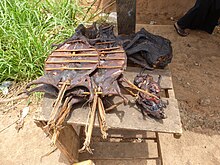
Back Bosvleis Afrikaans لحوم الأدغال Arabic Бушмийт Bulgarian Bushmeat Danish Bushmeat German Carne de animales silvestres Spanish گوشت شکار Persian Bushmeat Finnish Viande de brousse French Daging semak ID
 Bushmeat is often smoked to preserve it | |
| Alternative names | Wild meat, wild game |
|---|---|
| Main ingredients | Wildlife |
Bushmeat is meat from wildlife species that are hunted for human consumption. Bushmeat represents a primary source of animal protein and a cash-earning commodity in poor and rural communities of humid tropical forest regions of the world.[1][2]
The numbers of animals killed and traded as bushmeat in the 1990s in West and Central Africa were thought to be unsustainable.[3] By 2005, commercial harvesting and trading of bushmeat was considered a threat to biodiversity.[4] As of 2016, 301 terrestrial mammals were threatened with extinction due to hunting for bushmeat including primates, even-toed ungulates, bats, diprotodont marsupials, rodents and carnivores occurring in developing countries.[5]
Bushmeat provides increased opportunity for transmission of several zoonotic viruses from animal hosts to humans, such as Ebolavirus and HIV.[6][7][8]
- ^ Nasi, R.; Brown, D.; Wilkie, D.; Bennett, E.; Tutin, C.; Van Tol, G. & Christophersen, T. (2008). Conservation and use of wildlife-based resources: the bushmeat crisis (PDF). CBD Technical Series no. 33. Montreal and Bogor: Secretariat of the Convention on Biological Diversity and Center for International Forestry Research (CIFOR). pp. 1–50.
- ^ Bennett, E. L.; Blencowe, E.; Brandon, K.; Brown, D.; Burn, R. W.; Cowlishaw, G.; Davies, G.; Dublin, H.; Fa, J. E.; Milner‐Gulland, E. J.; Robinson, J. G.; Rowcliffe, J. M.; Underwood, F. M. & Wilkie, D. S. (2007). "Hunting for consensus: reconciling bushmeat harvest, conservation, and development policy in West and Central Africa". Conservation Biology. 21 (3): 884–887. doi:10.1111/j.1523-1739.2006.00595.x. PMID 17531066. S2CID 38428707.
- ^ Bowen-Jones, E. & Pendry, S. (1999). "The threats to primates and other mammals from the bushmeat trade in Africa and how this could be diminished". Oryx. 33 (3): 233–247. doi:10.1046/j.1365-3008.1999.00066.x.
- ^ Cowlishaw, G.; Mendelson, S. & Rowcliffe, J. (2005). "Evidence for post‐depletion sustainability in a mature bushmeat market". Journal of Applied Ecology. 42 (3): 460–468. doi:10.1111/j.1365-2664.2005.01046.x.
- ^ Ripple, W. J.; Abernethy, K.; Betts, M. G.; Chapron, G.; Dirzo, R.; Galetti, M.; Levi, T.; Lindsey, P. A.; Macdonald, D. W.; Machovina, B.; Newsome, T. M.; Peres, C. A.; Wallach, A. D.; Wolf, C. & Young, H. (2016). "Bushmeat hunting and extinction risk to the world's mammals". Royal Society Open Science. 3 (10): 160498. Bibcode:2016RSOS....360498R. doi:10.1098/rsos.160498. PMC 5098989. PMID 27853564.
- ^ Georges-Courbot, M. C.; Sanchez, A.; Lu, C. Y.; Baize, S.; Leroy, E.; Lansout-Soukate, J.; Tévi-Bénissan, C.; Georges, A. J.; Trappier, S. G.; Zaki, S. R.; Swanepoel, R.; Leman, P. A.; Rollin, P. E.; Peters, C. J.; Nichol, S. T. & Ksiazek, T. G. (1997). "Isolation and phylogenetic characterization of Ebola viruses causing different outbreaks in Gabon". Emerging Infectious Diseases. 3 (1): 59–62. doi:10.3201/eid0301.970107. PMC 2627600. PMID 9126445.
- ^ McMichael, A. J. (2002). "Population, environment, disease, and survival: past patterns, uncertain futures" (PDF). The Lancet. 359 (9312): 1145–1148. doi:10.1016/s0140-6736(02)08164-3. PMID 11943282. S2CID 9159650.
- ^ Karesh, W. B. & Noble, E. (2009). "The bushmeat trade: Increased opportunities for transmission of zoonotic disease". Mount Sinai Journal of Medicine: A Journal of Translational and Personalized Medicine. 76 (5): 429–444. doi:10.1002/msj.20139. PMID 19787649.
© MMXXIII Rich X Search. We shall prevail. All rights reserved. Rich X Search